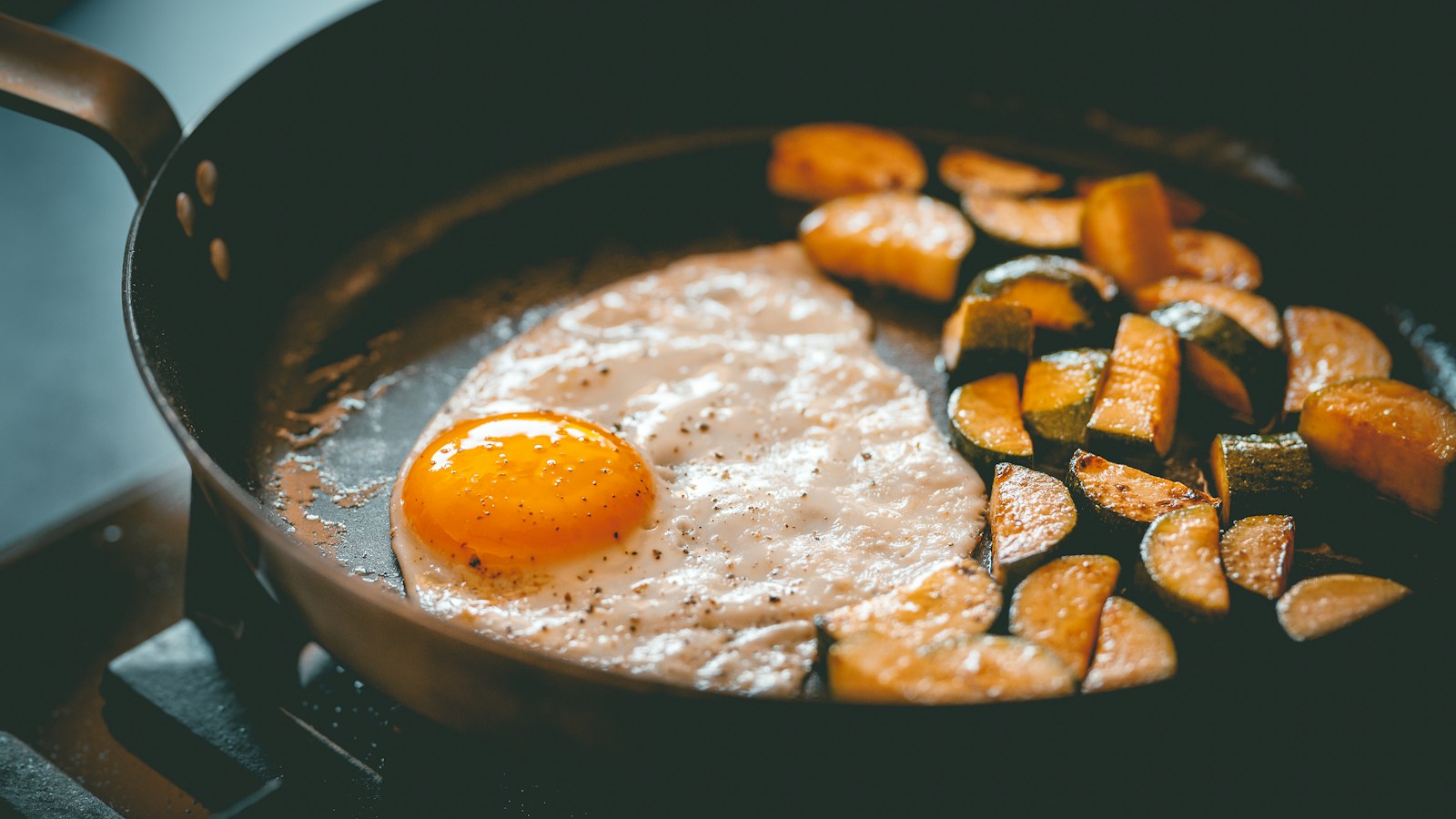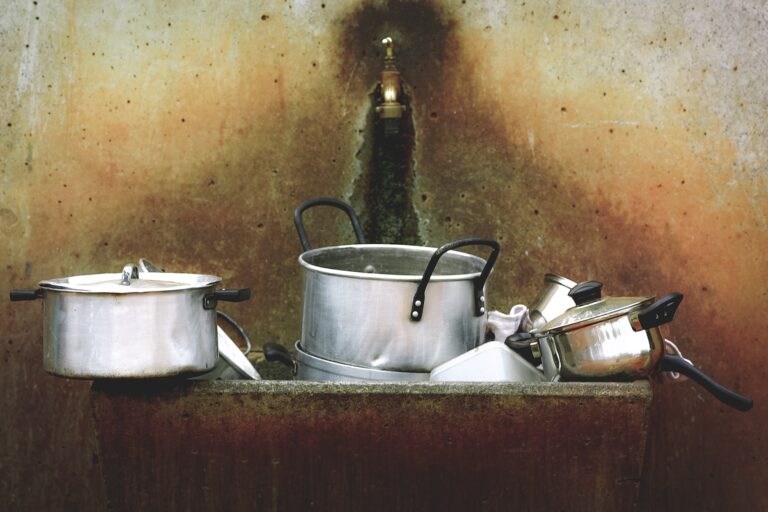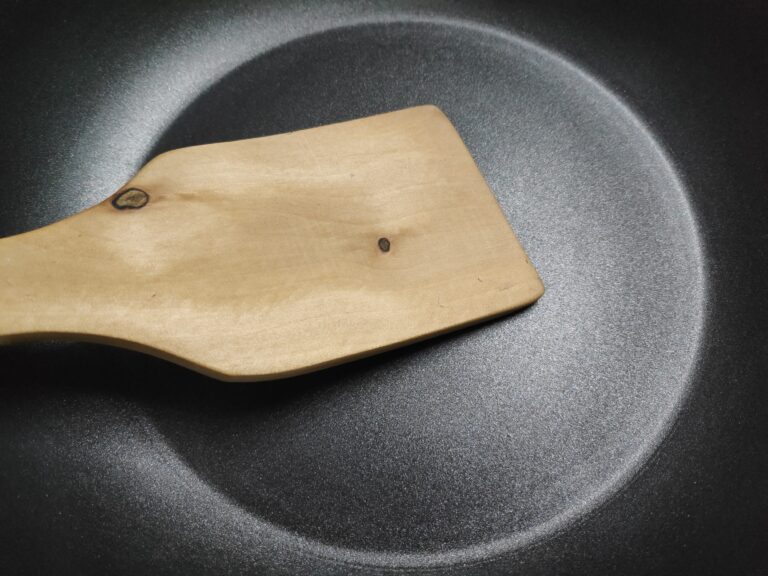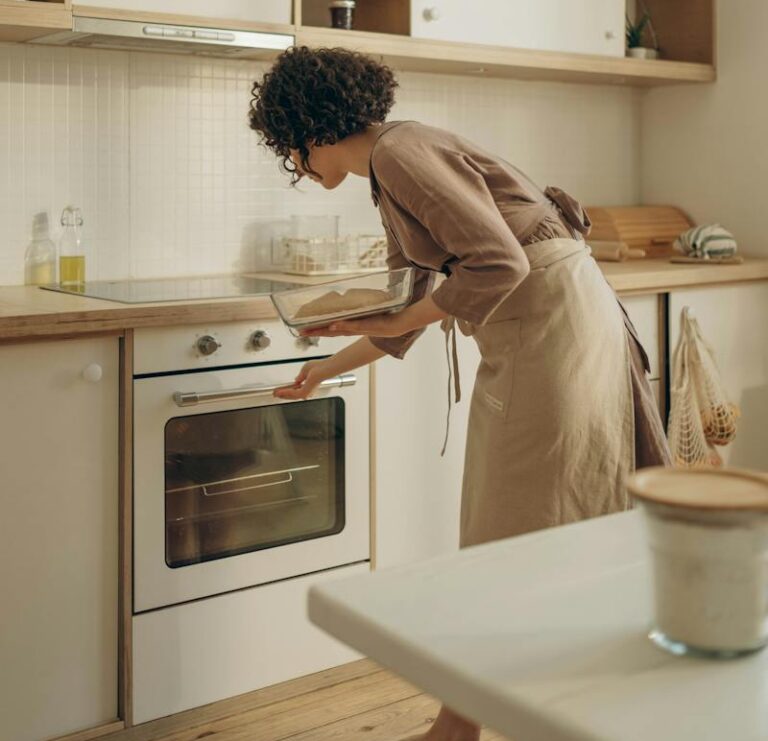Are you tired of food sticking to your cookware? Discover the best non-stick material for your kitchen needs.
In this article, we’ll explore the pros and cons of Teflon coating, the benefits of ceramic non-stick cookware, and why stainless steel might be the ultimate option.
We’ll also take an in-depth look at cast iron, anodized aluminum, copper, and even silicone as surprising contenders.
Finally, we’ll compare PTFE and Pfoa-Free options to help you make an informed decision.
Key Takeaways
- Ceramic coatings provide excellent non-stick properties and are easy to clean and maintain.
- Ceramic cookware is durable and can withstand high temperatures, while also being resistant to scratches.
- Ceramic cookware is free of harmful chemicals like PFOA and PTFE, providing a safer cooking experience.
- Alternative non-stick materials like silicone and cast iron offer durability, superior non-stick properties, and ease of maintenance.

The Pros and Cons of Teflon Coating
Teflon coating has its advantages and disadvantages when it comes to non-stick cookware. While it provides an effortless cooking and cleaning experience, there are health risks associated with it.
When heated to high temperatures, Teflon can release toxic fumes that are harmful when inhaled. These fumes can cause flu-like symptoms known as polymer fume fever. Additionally, if the Teflon coating gets scratched or damaged, it can release toxic chemicals into your food.
To avoid these risks, it’s important to use Teflon cookware on low to medium heat and replace it if it becomes scratched. If you’re concerned about the health risks, there are alternative non-stick coatings available. Ceramic and stainless steel coatings are popular choices, as they don’t release harmful chemicals when heated.

The Benefits of Ceramic Non-Stick Cookware
If you’re looking for a non-stick cookware option that’s both durable and offers health benefits, ceramic non-stick cookware may be the perfect choice for you.
With its strong and long-lasting surface, ceramic cookware can withstand high temperatures and resist scratches.
Additionally, ceramic non-stick coating is free of harmful chemicals like PFOA and PTFE, ensuring a healthier cooking experience.
Durability of Ceramic
Ceramic pans are known for their durability and can withstand high temperatures without losing their non-stick properties. This makes them an excellent choice for your cookware needs. Not only do they provide a non-stick surface for easy cooking and cleaning, but they are also built to last. The durability of ceramic cookware means that it can handle the wear and tear of everyday cooking without losing its effectiveness. Cleaning ceramic cookware is a breeze as well. Simply wipe away any residue with a soft sponge or cloth, and you’re good to go. No need for harsh scrubbing or abrasive cleaners. With ceramic cookware, you can enjoy the benefits of non-stick cooking without the hassle of difficult maintenance.
Here is a table to show the comparison between ceramic cookware and other non-stick materials:
| Material | Durability | Cleaning Ease | Non-Stick Properties |
|---|---|---|---|
| Ceramic | High | Easy | Excellent |
| Teflon | Medium | Moderate | Good |
| Stainless Steel | High | Moderate | Fair |
| Cast Iron | High | Difficult | Excellent |
| Aluminum | Medium | Easy | Good |
As you can see, ceramic cookware stands out in terms of durability and ease of cleaning. It is a reliable option that will make your cooking experience enjoyable and hassle-free.
Health Benefits of Ceramic
When it comes to your health, ceramic pans are a great option because they’re free from harmful chemicals and toxins. The benefits of using ceramic cookware are numerous.
Firstly, ceramic pans provide excellent non-stick properties, making them perfect for cooking without the need for excessive oil or butter. This can help reduce your overall calorie intake and promote a healthier lifestyle.
Additionally, ceramic pans are scratch-resistant and durable, ensuring they last longer and maintain their non-stick surface. On the other hand, traditional non-stick coatings often contain chemicals like PFOA and PFOS, which have been linked to adverse health effects.
These chemicals can leach into your food when the coating deteriorates or scratches, potentially posing health risks. By switching to ceramic cookware, you can enjoy the convenience of non-stick cooking without compromising your health.
Cooking Performance With Ceramic
You’ll love how evenly ceramic pans distribute heat while cooking. Ceramic cookware is known for its excellent heat distribution, ensuring that your food cooks evenly every time. Whether you’re searing a steak or simmering a delicate sauce, ceramic pans will provide consistent results.
When it comes to cooking temperature, ceramic pans can handle high heat without warping or releasing toxic chemicals. They are oven-safe and can be used on the stovetop at high temperatures, making them versatile for all your cooking needs.
In terms of cleaning, ceramic pans are relatively easy to maintain. They have a non-stick surface that prevents food from sticking, making cleanup a breeze. You can simply wipe off any residue with a soft cloth or sponge. Avoid using abrasive cleaners or metal utensils that could damage the ceramic coating.
To summarize, ceramic pans offer excellent heat distribution, can withstand high cooking temperatures, and are easy to clean. They are a fantastic choice for any home cook looking for reliable and convenient cookware.
| Cooking Performance | High Heat Resistance | Easy to Clean |
|---|---|---|
| Even heat distribution | Oven-safe | Non-stick surface |
| Consistent cooking | Withstands high temperatures | Simple cleanup process |
| Versatile for all dishes |
Stainless Steel: Is It the Ultimate Non-Stick Material?
If you’re looking for the ultimate non-stick material for your cookware, stainless steel might just be the answer. With its smooth surface and excellent heat conductivity, stainless steel provides a reliable cooking experience.
Plus, it’s durable and resistant to scratches, making it a long-lasting option for your kitchen.
Stainless Steel Benefits
Stainless steel is a great choice for cookware because it’s durable and resistant to rust. When it comes to maintenance, stainless steel is relatively easy to clean. Simply wash it with warm soapy water and dry it thoroughly to prevent water spots.
Unlike other materials, stainless steel doesn’t require special care or seasoning to maintain its non-stick properties. It also offers excellent cooking performance. Stainless steel has the ability to distribute heat evenly, allowing for consistent cooking results. It’s also non-reactive, meaning it won’t interact with acidic or alkaline foods, ensuring the original taste and flavor of your dishes.
With stainless steel cookware, you can enjoy hassle-free cooking and long-lasting durability.
Longevity of Stainless Steel
Now, let’s talk about the longevity of stainless steel cookware and some maintenance tips to keep it in top shape. Stainless steel is known for its durability and resistance to corrosion, making it a popular choice among home cooks and professional chefs alike. With proper care, stainless steel cookware can last a lifetime.
To ensure the longevity of your stainless steel cookware, here are some maintenance tips to keep in mind:
- Avoid using abrasive cleaners or scrubbers that can scratch the surface.
- Hand wash your stainless steel cookware with warm, soapy water and a soft sponge.
- Dry your cookware thoroughly after washing to prevent water spots and potential rusting.
- To remove stubborn stains or burnt-on food, try soaking the cookware in a mixture of vinegar and water before cleaning.
By following these simple maintenance tips, you can extend the lifespan of your stainless steel cookware and continue to enjoy its benefits for years to come.
| Maintenance Tips for Stainless Steel Cookware |
|---|
| 1. Avoid abrasive cleaners or scrubbers |
| 2. Hand wash with warm, soapy water |
| 3. Dry thoroughly after washing |
| 4. Soak in vinegar and water for stubborn stains |
Maintenance Required for Stainless Steel?
To keep your stainless steel cookware in top condition, remember to dry it thoroughly after washing to prevent water spots and potential rusting. Stainless steel maintenance tips are essential for prolonging the lifespan of your cookware.
After washing, use a soft cloth or towel to dry the cookware completely. This will help prevent any water spots or stains from forming on the surface.
Additionally, cleaning stainless steel cookware regularly is important. Avoid using abrasive cleaners or scrub brushes, as they can scratch the surface. Instead, opt for mild dish soap and warm water.
For stubborn stains or burnt-on food, you can use a mixture of baking soda and water to gently scrub the cookware.
Following these simple maintenance tips will keep your stainless steel cookware looking great and functioning properly for years to come.

Cast Iron as a Non-Stick Option
If you’re considering cast iron as a non-stick option, it’s important to understand its unique benefits and maintenance requirements.
Cast iron has several benefits that make it a popular choice for cooking. Firstly, it has excellent heat retention and distribution, allowing for even cooking. It also provides natural non-stick properties when properly seasoned.
Seasoning cast iron involves coating the surface with a layer of oil or fat and then heating it to create a polymerized layer that acts as a non-stick coating. This process not only enhances the non-stick properties but also prevents rust and improves the durability of the cookware.
However, it’s essential to avoid using soap or harsh detergents when cleaning cast iron, as it can strip away the seasoning. Instead, use a brush or scraper and hot water to clean it.
With proper care, cast iron can last a lifetime and provide you with excellent non-stick cooking.
The Rise of Copper as a Non-Stick Material in Cookware
You may be surprised to learn that copper has gained popularity as a non-stick material in cookware. Its exceptional conductivity allows for even heat distribution, ensuring that your food is cooked to perfection every time. Here are a few reasons why copper cookware is becoming so popular:
- Superior heat conductivity: Copper conducts heat faster and more evenly than other materials, making it ideal for cooking delicate dishes.
- Quick response to temperature changes: Copper cookware responds quickly to changes in heat, giving you precise control over your cooking.
- Non-stick properties: When properly cared for, copper develops a natural non-stick surface, reducing the need for excessive oil or butter.
- Beautiful aesthetic: Copper cookware adds a touch of elegance to your kitchen with its warm, metallic sheen.
- Long-lasting durability: With proper maintenance, copper cookware can last for generations, making it a worthwhile investment for any home chef.
With its impressive conductivity and growing popularity, it’s no wonder that copper cookware is becoming a top choice for many culinary enthusiasts.
Silicone: A Surprising Contender in the Non-Stick Game
Silicone may not be the first material that comes to mind when thinking about non-stick options, but it has quickly gained recognition for its impressive performance in the kitchen.
When comparing silicone vs. Teflon, silicone offers some distinct advantages. Unlike Teflon, silicone is more durable and can withstand higher temperatures without releasing toxic fumes. It’s also more scratch-resistant, making it a safer option for cooking utensils.
Additionally, silicone is a better alternative to ceramic. While ceramic coatings can chip or crack over time, silicone remains intact and doesn’t require delicate handling. Silicone’s non-stick properties are also superior to ceramic, making it easier to clean and maintain.
Comparing Non-Stick Alternatives: PTFE Vs. Pfoa-Free Options
If you’re trying to choose between PTFE and PFOA-free non-stick options, it’s important to understand the key differences and potential health concerns associated with each.
Here’s a quick comparison to help you make an informed decision:
PTFE (Polytetrafluoroethylene):
- Known for its exceptional non-stick properties.
- Requires less oil or butter for cooking.
- Can withstand high temperatures without releasing toxic fumes.
- May contain PFOA (Perfluorooctanoic acid), a potentially harmful chemical.
Ceramic:
- Made from inorganic materials.
- Provides a natural non-stick surface.
- Requires more oil or butter for cooking.
- May not handle high temperatures as well as PTFE.
- Typically PFOA-free, offering a safer alternative.
When comparing the performance of PFOA-free options, both PTFE and ceramic have their advantages. Consider your cooking needs and health concerns to determine which option is safer for you.
Conclusion
In conclusion, the best non-stick material for cookware ultimately depends on personal preferences and cooking needs. Teflon coating offers convenience but has concerns about potential health risks.
Ceramic non-stick cookware is a popular choice for its durability and safety. Stainless steel provides excellent heat conductivity and durability but may require more oil or butter for cooking.
Cast iron is a traditional and reliable option, known for its excellent heat retention. Anodized aluminum offers durability and even heat distribution. Copper is a premium choice for its exceptional heat conductivity.
Lastly, silicone provides a surprising non-stick option with its flexibility and heat resistance. Consider your cooking style and needs when choosing the best non-stick material for your cookware.




